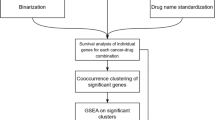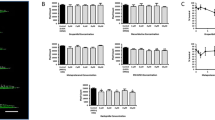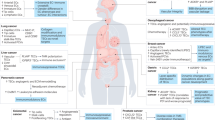Abstract
Artemisinin (ARS) and its derivatives are used for the second-line therapy of malaria infections with Plasmodium falciparum and P. vivax. ARSs also reveal profound antitumor activity in vitro and in vivo. In the present investigation, we correlated the mRNA expression data of 89 angiogenesis-related genes obtained by microarray hybridization from the database of the US National Cancer Institute with the 50% growth inhibition concentration values for eight ARSs (ARS, arteether (ARE), artesunate (ART), artemisetene, arteanuine B, dihydroartemisinylester stereoisomers 1 and 2). The constitutive expression of 30 genes correlated significantly with the cellular response to ARSs. By means of hierarchical cluster analysis and cluster image mapping expression, profiles were identified that determined significantly the cellular response to ART, ARE, artemether and dihydroartemisinylester stereoisomer 1. We have exemplarily validated the microarray data of six out of these 30 genes by real-time RT-PCR in seven cell lines. The fact that sensitivity and resistance of tumor cells could be predicted by the mRNA expression of angiogenesis-related genes indicate that ARSs reveal their antitumor effects at least in part by inhibition of tumor angiogenesis. As many chemopreventive drugs exert antiangiogenic features, ARSs might also be chemopreventive in addition to their cytotoxic effects.
This is a preview of subscription content, access via your institution
Access options
Subscribe to this journal
Receive 6 print issues and online access
$259.00 per year
only $43.17 per issue
Buy this article
- Purchase on Springer Link
- Instant access to full article PDF
Prices may be subject to local taxes which are calculated during checkout


Similar content being viewed by others
Abbreviations
- ARAB:
-
arteanuine B
- ARE:
-
arteether
- ARM:
-
artemether
- ARS:
-
artemisinin
- ART:
-
artesunate
- ARTEMIS:
-
artemisitene
- ARTEST1/2:
-
dihydroartemisinyl ester stereoisomers 1/2
- IC50:
-
inhibition concentration 50%
- NCI:
-
National Cancer Institute
References
Kerbel R, Folkman J . Clinical translation of angiogenesis inhibitors. Nat Rev Cancer 2002; 2: 727–739.
Shimizu K, Oku N . Cancer anti-angiogenic therapy. Biol Pharm Bull 2004; 27: 599–605.
Folkman J . The role of angiogenesis in tumor growth. Semin Cancer Biol 1992; 3: 65–71.
Relf M, LeJeune S, Scott PA, Fox S, Smith K, Leek R et al. Expression of the angiogenic factors vascular endothelial cell growth factor, acidic and basic fibroblast growth factor, tumor growth factor beta-1, platelet-derived endothelial cell growth factor, placenta growth factor, and pleiotrophin in human primary breast cancer and its relation to angiogenesis. Cancer Res 1997; 57: 963–969.
Robert A, Dechy-Cabaret O, Cazelles J, Meunier B . From mechanistic studies on artemisinin derivatives to new modular antimalarial drugs. Acc Chem Res 2002; 35: 167–174.
Ribeiro IR, Olliaro P . Safety of artemisinin and its derivatives. A review of published and unpublished clinical trials. Med Trop (Mars) 1998; 58: 50–53.
Johann-Liang R, Albrecht R . Safety evaluations of drugs containing artemisinin derivatives for the treatment of malaria. Clin Infect Dis 2003; 36: 1626–1627.
Posner GH, Wang D, Cumming JN, Oh CH, French AN, Bodley AL et al. Further evidence supporting the importance of and the restrictions on a carbon-centered radical for high antimalarial activity of 1,2,4-trioxanes like artemisinin. J Med Chem 1995; 38: 2273–2275.
Posner GH, McGarvey DJ, Oh CH, Kumar N, Meshnick SR, Asawamahasadka W . Structure–activity relationships of lactone ring-opened analogs of the antimalarial 1,2,4-trioxane artemisinin. J Med Chem 1995; 38: 607–612.
Posner GH, Oh CH, Wang D, Gerena L, Milhous WK, Meshnick SR et al. Mechanism-based design, synthesis, and in vitro antimalarial testing of new 4-methylated trioxanes structurally related to artemisinin: the importance of a carbon-centered radical for antimalarial activity. J Med Chem 1994; 37: 1256–1258.
Pandey AV, Tekwani BL, Singh RL, Chauhan VS . Artemisinin, an endoperoxide antimalarial, disrupts the hemoglobin catabolism and heme detoxification systems in malarial parasite. J Biol Chem 1999; 274: 19383–19388.
Meshnick SR, Yang YZ, Lima V, Kuypers F, Kamchonwongpaisan S, Yuthavong Y . Iron-dependent free radical generation from the antimalarial agent artemisinin (qinghaosu). Antimicrob Agents Chemother 1993; 37: 1108–1114.
Adjuik M, Babiker A, Garner P, Olliaro P, Taylor W, White N, International Artemisinin Study Group. Artesunate combinations for treatment of malaria: meta-analysis. Lancet 2004; 363: 9–17.
Dorsey G, Vlahos J, Kamya MR, Staedke SG, Rosenthal PJ . Prevention of increasing rates of treatment failure by combining sulfadoxine-pyrimethamine with artesunate or amodiaquine for the sequential treatment of malaria. J Infect Dis 2003; 188: 1231–1238.
Chen HH, Zhou HJ, Fang X . Inhibition of human cancer cell line growth and human umbilical vein endothelial cell angiogenesis by artemisinin derivatives in vitro. Pharmacol Res 2003; 48: 231–236.
Efferth T, Rücker G, Falkenberg M, Manns D, Olbrich A, Fabry U et al. Detection of apoptosis in KG-1a leukemic cells treated with investigational drugs. Arzneimittelforschung 1996; 46: 196–200.
Efferth T, Dunstan H, Sauerbrey A, Miyachi H, Chitambar CR . The anti-malarial artesunate is also active against cancer. Int J Oncol 2001; 18: 767–773.
Efferth T, Olbrich A, Bauer R . mRNA expression profiles for the response of human tumor cell lines to the antimalarial drugs artesunate, arteether, and artemether. Biochem Pharmacol 2002; 64: 617–623.
Efferth T, Sauerbrey A, Olbrich A, Gebhart E, Rauch P, Weber HO et al. Molecular modes of action of artesunate in tumor cell lines. Mol Pharmacol 2003; 64: 382–394.
Efferth T, Briehl MM, Tome ME . Role of antioxidant genes for the activity of artesunate against tumor cells. Int J Oncol 2003; 23: 1231–1235.
Posner GH, Ploypradith P, Parker MH, O'Dowd H, Woo SH, Northrop J et al. Antimalarial, antiproliferative, and antitumor activities of artemisinin-derived, chemically robust, trioxane dimers. J Med Chem 1999; 42: 4275–4280.
Posner GH, McRiner AJ, Paik IH, Sur S, Borstnik K, Xie S et al. Anticancer and antimalarial efficacy and safety of artemisinin-derived trioxane dimers in rodents. J Med Chem 2004; 47: 1299–1301.
Posner GH, Paik IH, Sur S, McRiner AJ, Borstnik K, Xie S et al. Orally active, antimalarial, anticancer, artemisinin-derived trioxane dimers with high stability and efficacy. J Med Chem 2003; 46: 1060–1065.
Woerdenbag HJ, Moskal TA, Pras N, Malingre TM, el-Feraly FS, Kampinga HH et al. Cytotoxicity of artemisinin-related endoperoxides to Ehrlich ascites tumor cells. J Nat Prod 1993; 56: 849–856.
Dell'Eva R, Pfeffer U, Vene R, Anfosso L, Forlani A, Albini A et al. Inhibition of angiogenesis in vivo and growth of Kaposi sarcoma xenograft tumors by the anti-malarial artesunate. Biochem Pharmacol 2004; 68: 2359–2366.
Chen HH, Zhou HJ, Fang X . Inhibition of human cancer cell line growth and human umbilical vein endothelial cell angiogenesis by artemisinin derivatives in vitro. Pharmacol Res 2003; 48: 231–236.
McCarty MF . Turning an ‘Achilles’ Heel' into an asset – activation of HIF-1alpha during angiostatic therapy will increase tumor sensitivity to iron-catalyzed oxidative damage. Med Hypotheses 2003; 61: 509–511.
Wartenberg M, Wolf S, Budde P, Grunheck F, Acker H, Hescheler J et al. The antimalaria agent artemisinin exerts antiangiogenic effects in mouse embryonic stem cell-derived embryoid bodies. Lab Invest 2003; 83: 1647–1655.
Chen HH, Zhou HJ, Wu GD, Lou XE . Inhibitory effects of artesunate on angiogenesis and on expressions of vascular endothelial growth factor and VEGF receptor KDR/flk-1. Pharmacology 2004a; 71: 1–9.
Chen HH, Zhou HJ, Wang WQ, Wu GD . Antimalarial dihydroartemisinin also inhibits angiogenesis. Cancer Chemother Pharmacol 2004b; 53: 423–432.
Oh S, Jeong IH, Ahn CM, Shin WS, Lee S . Synthesis and antiangiogenic activity of thioacetal artemisinin derivatives. Bioorg Med Chem 2004; 12: 3783–3790.
Huan-Huan C, Li-Li Y, Shang-Bin L . Artesunate reduces chicken chorioallantoic membrane neovascularisation and exhibits antiangiogenic and apoptotic activity on human microvascular dermal endothelial cell. Cancer Lett 2004; 211: 163–173.
Scherf U, Ross DT, Waltham M, Smith LH, Lee JK, Tanabe L et al. A gene expression database for the molecular pharmacology of cancer. Nat Genet 2000; 24: 236–244.
Alley MC, Scudiero DA, Monks A, Hursey ML, Czerwinski MJ, Fine DL et al. Feasibility of drug screening with panels of human tumor cell lines using a microculture tetrazolium assay. Cancer Res 1988; 48: 589–601.
Rubinstein LV, Shoemaker RH, Paull KD, Simon RM, Tosini S, Skehan P et al. Comparison of in vitro anticancer-drug-screening data generated with a tetrazolium assay versus a protein assay against a diverse panel of human tumor cell lines. J Natl Cancer Inst 1990; 82: 1113–1138.
Pfaffl MW, Tichopad A, Prgomet C, Neuvians TP . Determination of stable housekeeping genes, differentially regulated target genes and sample integrity: Bestkeepr-Excel-based tool using pair-wise correlations. Biotechnol Lett 2004; 26: 509–515.
Müller PY, Janovjak H, Miserez AR, Dobbie Z . Processing of gene expression data generated by quantitative real-time RT-PCR. Biotechniques 2002; 32: 1372–1378.
Peale Jr FV, Gerritsen ME . Gene profiling techniques and their application in angiogenesis and vascular development. J Pathol 2001; 195: 7–19.
Ferrara N . Vascular endothelial growth factor: basic science and clinical progress. Endocr Rev 2004; 25: 581–611.
Hanahan D, Folkman J . Patterns and emerging mechanisms of the angiogenic switch during tumorigenesis. Cell 1996; 86: 353–364.
Ferrari N, Morini M, Pfeffer U, Minghelli S, Noonan DM, Albini A . Inhibition of Kaposi's sarcoma in vivo by fenretinide. Clin Cancer Res 2003; 9: 6020–6029.
Ferrari N, Pfeffer U, Dell'Eva R, Ambrosini C, Noonan DM, Albini A . The TGF-beta family members BMP-2 and MIC-1 as mediators of the anti-angiogenic activity of 4-hydroxyphenylretinamide. Clin Cancer Res 2005; 11: 4610–4619.
Tischer E, Mitchell R, Hartman T, Silva M, Gospodarowicz D, Fiddes JC et al. The human gene for vascular endothelial growth factor. Multiple protein forms are encoded through alternative exon splicing. J Biol Chem 1991; 266: 11947–11954.
Olofsson B, Pajusola K, von Euler G, Chilov D, Alitalo K, Eriksson U . Genomic organization of the mouse and human genes for vascular endothelial growth factor B (VEGF-B) and characterization of a second splice isoform. J Biol Chem 1996; 271: 19310–19317.
Joukov V, Pajusola K, Kaipainen A, Chilov D, Lantinen I, Kukk E et al. A novel vascular endothelial growth factor, VEGF-C, is a ligand for the Flt4 (VEGFR-3) and KDR (VEGFR-2) receptor tyrosine kinases. EMBO J 1996; 15: 290–298.
Lee J, Gray A, Yuan J, Luoh S-M, Avraham H, Wood WI . Vascular endothelial growth factor- related protein: a ligand and specific activator of the tyrosine kinase receptor Flt4. Proc Natl Acad Sci USA 1996; 93: 1988–1992.
Jeong SJ, Itokawa T, Shibuya M, Kuwano M, Ono M, Higuchi R et al. Costunolide, a sesquiterpene lactone from Saussurea lappa, inhibits the VEGFR KDR/Flk-1 signaling pathway. Cancer Lett 2002; 187: 129–133.
Wang S, Zheng Z, Weng Y, Yu Y, Zhang D, Fan W et al. Angiogenesis and anti- angiogenesis activity of Chinese medicinal herbal extracts. Life Sci 2004; 74: 2467–2478.
Gong YQ, Fan Y, Wu DZ, Yang H, Hu ZB, Wang ZT . In vivo and in vitro evaluation of erianin, a novel anti-angiogenic agent. Eur J Cancer 2004; 40: 1554–1565.
Kim MS, Lee YM, Moon EJ, Kim SE, Lee JJ, Kim KW . Anti-angiogenic activity of torilin, a sesquiterpene compound isolated from Torilis japonica. Int J Cancer 2000; 87: 269–275.
Kurachi K, Davie EW, Strydom DJ, Riordan JF, Vallee BL . Sequence of the cDNA and gene for angiogenin, a human angiogenesis factor. Biochemistry 1985; 24: 5494–5499.
Kunz M, Möller S, Koczak D, Lorenz P, Wenger RH, Glocker MO et al. Mechanisms of hypoxic gene regulation of angiogenesis factor Cyr61 in melanoma cells. J Biol Chem 2003; 278: 45651–45660.
Hahm ER, Gho YS, Park S, Park C, Kim KW, Yang CH . Synthetic curcumin analogs inhibit activator protein-1 transcription and tumor-induced angiogenesis. Biochem Biophys Res Commun 2004; 321: 337–344.
Dorai T, Aggarwal BB . Role of chemopreventive agents in cancer therapy. Cancer Lett 2004; 21: 129–140.
Yamakawa S, Asai T, Uchida T, Matsukawa M, Akizawa T, Oku N . (−)-Epigallocatechin gallate inhibits membrane-type 1 matrix metalloproteinase, MT1-MMP, and tumor angiogenesis. Cancer Lett 2004; 210: 47–55.
Garbisa S, Biggin S, Cavallarin N, Sartor L, Benelli R, Albini A . Tumor invasion: molecular shears blunted by green tea. Nat Med 1999; 5: 1216.
Bergers G, Benjamin LE . Tumorigenesis and the angiogenic switch. Nat Rev Cancer 2003; 3: 401–410.
Heissig B, Hattori K, Friedrich M, Rafii S, Werb Z . Angiogenesis: vascular remodeling of the extracellular matrix involves metalloproteinases. Curr Opin Hematol 2003; 10: 136–141.
Su SJ, Yeh TM, Chuang WJ, Ho CL, Chang KL, Cheng HL et al. The novel targets for anti-angiogenesis of genistein on human cancer cells. Biochem Pharmacol 2005; 69: 307–318.
Pfeffer U, Ferrari N, Dell'Eva R, Indraccolo S, Morini M, Noonan DM et al. Molecular mechanisms of action of angiopreventive anti-oxidants on endothelial cells: microarray gene expression analyses. Mutat Res 2005; 59: 198–211.
Tosetti F, Ferrari N, De Flora S, Albini A . Angioprevention': angiogenesis is a common and key target for cancer chemopreventive agents. FASEB J 2002; 16: 2–14.
Pfeffer U, Ferrari N, Morini M, Benelli R, Noonan DM, Albini A . Antiangiogenic activity of chemopreventive drugs. Int J Biol Markers 2003; 18: 70–74.
Acknowledgements
The present work was supported by grants from CIPE-Regione Liguria, Associazione Italiana per la Ricerca sul Cancro (AIRC), Compagnia San Paolo di Torino, and MIUR-FIRB.
Author information
Authors and Affiliations
Corresponding author
Additional information
Supplementary Information accompanies the paper on The Pharmacogenomics Journal website http://www.nature.com/tpj)
Supplementary information
Rights and permissions
About this article
Cite this article
Anfosso, L., Efferth, T., Albini, A. et al. Microarray expression profiles of angiogenesis-related genes predict tumor cell response to artemisinins. Pharmacogenomics J 6, 269–278 (2006). https://doi.org/10.1038/sj.tpj.6500371
Received:
Revised:
Accepted:
Published:
Issue Date:
DOI: https://doi.org/10.1038/sj.tpj.6500371
Keywords
This article is cited by
-
Artemisinin and its derivatives: a promising cancer therapy
Molecular Biology Reports (2020)
-
Functionalization of iron oxide nanoparticles with clove extract to induce apoptosis in MCF-7 breast cancer cells
3 Biotech (2020)
-
A phase I study of intravenous artesunate in patients with advanced solid tumor malignancies
Cancer Chemotherapy and Pharmacology (2018)
-
Small Molecular-Sized Artesunate Attenuates Ocular Neovascularization via VEGFR2, PKCα and PDGFR Targets
Scientific Reports (2016)
-
Role of angiogenic factors of herbal origin in regulation of molecular pathways that control tumor angiogenesis
Tumor Biology (2016)



